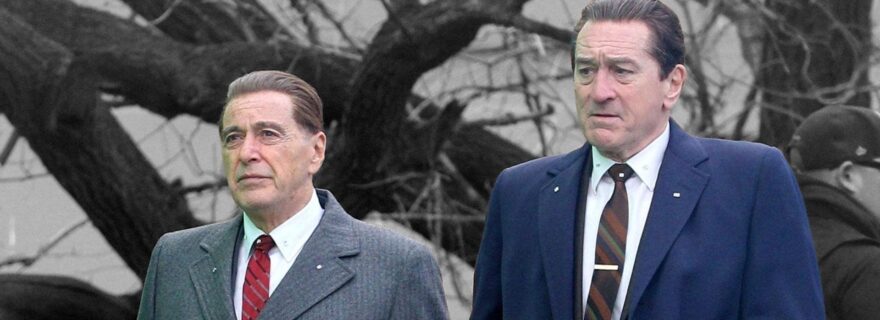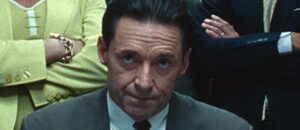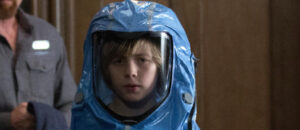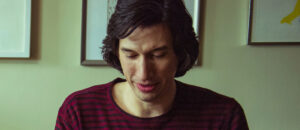The Irishman
Movie Rating:
5
With a running time of just under 3 ½ hours, I’m less time away from The Irishman writing this review than it took to watch the film, yet even in these moments following the first screening, it feels like if I’ve witnessed something truly special.
In a year where numerous movies feel like the culmination of their masters’ craft, likely no film speaks as well to the dream scenario where a legendary director and his retinue of iconic performers manage to keep their flames of talent alive and make something that’s both steeped in the past but, in its own way, also brilliantly, bravely new.
Martin Scorsese and Robert De Niro tried to adapt Charles Brandt’s I Heard You Paint Houses for over a decade. The book is a non-fiction memoir about Frank Sheeran, a notorious Mafia enforcer who worked directly with Jimmy Hoffa. Ostensibly a thematic continuation of the style made famous by their Goodfellas and Casino, the script by Oscar-winning screenwriter Steven Zaillian provides many echoes to Scorsese’s ouvre. However, the film is equally a surprise, far funnier and more overtly nostalgic than the gangster movies with which Scorsese and these actors are often associated.
De Niro plays Sheeran, a blue-eyed Army vet who drives a truck for a living. After a chance encounter with Russell (Joe Pesci), the two find themselves connected and form a partnership that will result in not only a decades-long friendship, but a body count to match the number of years. Al Pacino (appearing for the first time in a Scorsese film) plays Jimmy Hoffa, leader of the powerful Teamsters union. Harvey Keitel has a small but pivotal role as mob boss Angelo Bruno, while a Boardwalk Empire reunion of sorts takes place showcasing Bobby Cannavale and Stephen Graham in excellent turns. Anna Paquin, Domenick Lombardozzi, Jesse Plemons, and Ray Romano also help bring the story to life.
The film takes place over decades, and the film uses extensive CGI to de-age the actors. Some may pick apart the technique, or even the need for it. (The Godfather Part II showed that different performers can play the same characters at different ages.) Still, the result is an unmatched continuity of performance. The visual transformation is often (but not always effectively) mirrored by the physical differences in movement and posture. These are old men playing younger versions of themselves, and sometimes the illusion does break down slightly, but the movie is so engaging that focusing on this element seems entirely beside the point.
The film is unabashedly violent, but it plays out in an appropriately operatic fashion. Some of Scorsese’s trademark visual elements – such as the glorious crane and tracking shots – are joined by super slow-motion moments that dive into the human choreography of violence. The film has a consistent visual language that borrows from the director’s previous pictures but never mimics them, which is a tribute to the creativity and experimentation expressed by cinematographer Rodrigo Prieto’s camerawork.
The story is deeply human. It explores broad notions of brotherhood, guilt, responsibility, and revenge, while at the same time delving in subtle and overt ways into political machinations both historic and contemporary. Above all is a coherence – moral, criminal, personal – to Frank’s actions, not simply sociopathy for the sake of violence, but a cold and clinical professionalism that doesn’t require overwrought reflection or heartless menace.
In many ways, the film is closest to Scorsese’s Casino, including the thematic connections between mob bosses, Cuba, the Teamsters, Las Vegas, and even Don Rickles. However, this feels like a totally different riff on these type of characters, even if the broader connections are easily found.
The soundtrack is a nice mix of needle-drops with a score by Robbie Robertson of The Band. The instrumentation sometimes adds to the sense of unease. The sound work throughout feels of a particular time, from the growl of the car engines to the blast of the revolvers. It’s an engrossing soundscape as palpable as the visual elements.
The Irishman plays with legends and mythmaking, twisting the tropes that Scorsese helped birth. The movie is both conspiratorial and emotionally generous. It’s a fascinating portrait of a man whose conflicts didn’t run into the maudlin or hysterical. Frank’s recollection has a taciturn precision, a matter-of-fact, almost journalistic distance that evokes deep emotions and regrets.
Look to the last, powerful shot for a reversal of The Godfather‘s famous closer just to see all the levels that this story is riffing on. Despite the numerous echoes, this film sings its own unique song. It powerfully and profoundly delves into flawed characters with a precision that no other filmmaker could have done with as much craft or class.
This is a movie no one wanted to make save for Netflix, and alas the vast majority of viewers will see it on screens far smaller than a film of this scope deserves. Bold, epic, and audacious, The Irishman would be an astonishing accomplishment for any filmmaker, but for a septuagenarian decades into his career, it’s a near miracle. It’s one of the best films of the year, made by one of the greatest directors who ever stood behind a camera.






David Krauss
I’m so excited for this! Glad to hear it lived up to and even exceeded expectations. Thanks for the great review!
Julian
CAN’T. WAIT. Great review, Jason!
Shannon Nutt
The latest trailer for this makes it look as good as GoodFellas. After reading this review, I’m really excited about seeing it.